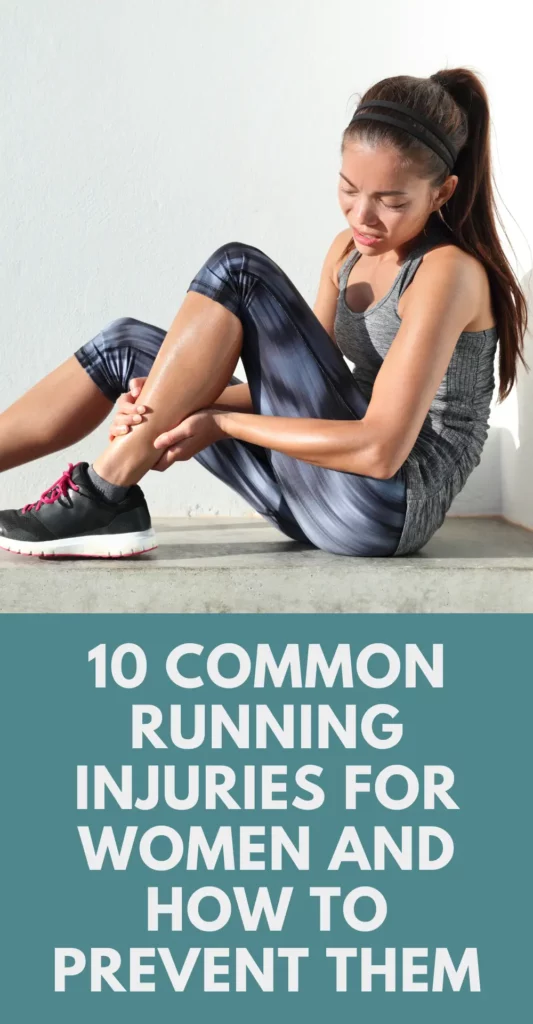Common running injuries for women often result from a combination of factors.
These include biomechanics and an individual’s anatomy, poor running form, training errors and footwear.
In order to stay injury free for longer, you need to be train smarter, not harder.
I remember when I first started running, I thought the more miles I ran, the better the runner I would become – oh boy was I wrong!
I used to run for miles and miles each week without a proper training strategy and I always used to wonder why I kept getting injured.
I didn’t do any strength training and I rarely warmed up before a run. Eek!
So how exactly can you prevent common running injuries for women? What training strategies can you leverage?
In this guide we’ll look at:
- 10 common running injuries for women
- 10 training strategies to prevent common running injuries
Ready?
Let’s get started!

10 common running injuries for women
Here are some common running injuries for women and the factors that contribute to them:
#1 Runner’s knee
Runner’s knee (also known as Patellofemoral Pain Syndrome) is a condition that involves pain around or behind the knee cap.
It is often linked to overuse, improper tracking of the knee cap, muscle imbalances or issues with the alignment of the leg and knee.
#2 Shin splints
Shin splints (also known as Medial Tibial Stress Syndrome) result from repetitive stress on the shinbone and the tissues attaching the shinbone to the muscles.
Contributing factors include overpronation (rolling the foot inward), running on hard surfaces or suddenly increasing the intensity or duration of training.
#3 Iliotibial (IT) band syndrome
IT band syndrome is characterised by pain on the outside of the knee and is often caused by the IT band rubbing against the lateral femoral epicondyle.
Factors contributing to IT band syndrome include muscle imbalances, overuse and running on banked surfaces.
#4 Stress fractures
Stress fractures are small cracks in the bone and are often a result of overtraining, inadequate rest or changes in training surfaces.
Insufficient calcium intake and vitamin D deficiency may also contribute to stress fractures.
#5 Achilles tendonitis
Inflammation of the Achilles tendon, which connects the calf muscles to the heel bone, can occur due to overtraining, improper footwear, tight calf muscles or sudden increases in training intensity.

#6 Plantar fasciitis
Plantar fasciitis is a condition involves inflammation of the plantar fascia, a band of tissue connecting the heel to the toes.
Factors contributing to plantar fasciitis include tight calf muscles, improper footwear, overpronation and excessive running on hard surfaces.
#7 Stiffness and lower back pain
Running can lead to lower back pain due to repetitive impact on the spine.
Weak core muscles, poor posture, and improper running form can contribute to stiffness and discomfort.
#8 Muscle strains
Strains can occur in various muscles, often due to inadequate warm-up, overuse or sudden increases in intensity.
Commonly affected muscles include the quadriceps, hamstrings and calf muscles.
#9 Achilles tendon rupture:
While less common, a complete tear of the Achilles tendon can occur, especially in individuals with weakened or degenerated tendons.
Sudden, forceful movements can contribute to this injury.
#10 Bunions and toe deformities:
Repetitive impact on the feet during running, along with factors like improper footwear, can contribute to the development of bunions and toe deformities.
Related: 6 injury prevention strategies for pain free running

10 training strategies to prevent running injuries
#1 Pay attention to your body
Listening to your body is a simple but powerful way to prevent common running injuries.
Next time you’re out on a run, take the time to really hone into what your body is telling you.
- Do you feel any pain or niggles?
- Do you feel any tightness in your muscles?
- Do your legs feel heavy and fatigued?
These signs are often your body’s way of telling you to slow down or switch up your training routine.
#2 Practice proper running form
Running form is probably one of the most neglected aspects of running.
Many runners don’t understand that there is actually a proper way to run – a way that places the least stress and strain on your body.
This includes everything from the way you carry yourself when running, the way your arms swing and the way your feet hit the ground when you run.
You can read more in my guide on proper running form.
#3 Warm up properly before a run
Runners have a love/hate relationship with the warm up.
The truth is a warm up will make your run a lot easier from the get go.
The first mile is always the hardest.
Your body needs time to adjust and by warming up you will get this over and done with during the warm up – meaning you will be able to hit the ground running on your run.
Focus on doing some light jogging and dynamic stretches as part of your warm up.
#4 Cool down after a run
Like the warm up, the cool down gets a bad rep in the running community.
Perhaps this is because there hasn’t been a whole lot of solid research over the years that looks at the benefits of a cool down.
Whether or not you fall into the cool down loving camp, there’s something to be said about doing a cool down after a strenuous workout.
Aim to do some light jogging and static stretches as part of a cool down.

#5 Invest in a pair of good running shoes
One of the best ways to prevent common running injuries is to wear a pair of decent running shoes.
This doesn’t mean visiting the first sports shoe shop you come across and picking a pair of stylish looking shoes.
Buying your first pair of running shoes should be seen as an investment.
Check out my guide on finding the right running shoes for more information.
#6 Avoid sudden leaps in training distance and/or intensity
Many injuries like shin splints and runner’s knee are caused by training errors.
If you suddenly increase your weekly mileage, for example, this will put unnecessary stress on your body as it needs time to adapt.
The general rule of thumb is to increase training distance and/or intensity by no more than 10% each week.
#7 Avoid running on hard surfaces all the time
Road running is a necessity for many runners who perhaps live in an urban area or prefer running on these types of surfaces.
But sometimes it’s good to switch up the surface on which you run to give your feet and joints a break.
Try running on grass for most or some parts of your run.
#8 Stretch and foam roll
Research has found that runners who stretch regularly can improve running economy and reduce perception of effort.
Foam rolling also has the potential to improve circulation and increase blood flow to your muscles.
This is important because it gets your body ready for a run and helps it recover afterwards.
#9 Strength train
Strength training helps to build stronger muscles, joints, ligaments and connective tissues.
This is so important for runners because running is a high impact sport.
Do you want to see improvements in your running performance and running form?
By doing at least two strength training sessions per week, you will be doing a lot to reduce the risk of injury.
Check out my strength training plans for more information:
- 14 day strength training plan for runners
- 30 day strength training plan for runners
- 30 day workout challenge for runners
#10 Cross train
Cross training is all about including a range of exercises and activities in your training plan.
The goal is to push your body and muscles in different ways and improve overall athletic performance.
Cross training focuses not only on your aerobic fitness, but looks to improve your:
- Flexibility
- Balance
- Coordination
- Core strength
- Endurance
Related: Running through the decades: What to expect in your 20s, 30s and 40s as a female runner
- 5 things I wish I’d known before returning to running - March 3, 2024
- Running 20 minutes a day: Benefits + how to start - January 27, 2024
- How to run your first 2 hour half marathon - January 16, 2024
